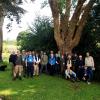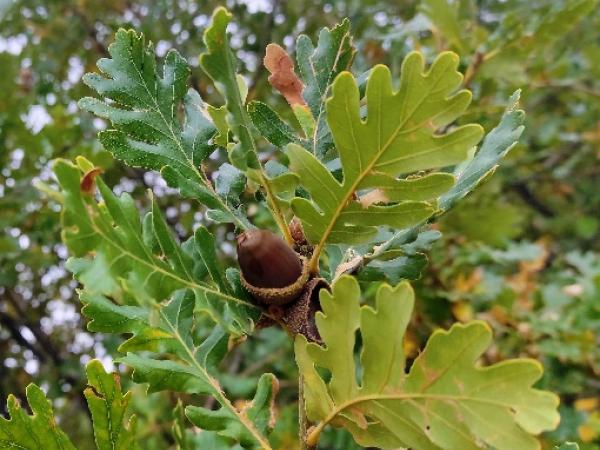Editor's Picks
Plant Focus
Charles H. Cannon
Published May 2019 in International Oaks No. 30: 69–76
Abstract
The Asian tropics and subtropics are home to several major lineages of the Fagaceae that are largely endemic to the region. The stone oaks (Lithocarpus), comprising over 250 species, show a large number of morphological and ecological similarities to oaks but also some major differences, like insect pollination and a unique fruit type. The tropical chestnuts (Castanopsis), with over 150 species, have an almost identical but slightly narrower geographic and ecological distribution as the stone oaks. Trigonobalanus is an ancient relictual genus of three species with a sparse distribution of small gregarious populations scattered in non-overlapping ranges in Southeast Asia and South America. These lineages offer a compelling set of comparative questions with Quercus about differences in ecology and evolution across biomes, continents, and millennia. As resources for the detailed study of the genus Quercus continue to develop rapidly, opportunities for transferring knowledge, protocols, and expertise to these comparative analyses with the Asian lineages should be actively pursued.
Keywords
Lithocarpus, Quercus, Trigonobalanus, Castanopsis, cupule evolution
References
Camus, A. 1952-1954. Les Chênes. Monographie du Genre Quercus. Tome III. Genre Quercus. Sous-genre Euquercus (Sections Protobalanus et Erythrobalanus). Monographie du genre Lithocarpus et Addenda aux Tomes I, II, III. Texte. Paris: Paul Lechevalier Editeur.
Cannon, C.H. 2001. Morphological and molecular diversity in Lithocarpus (Fagaceae) of Mount Kinabalu. Sabah Parks Nature Journal 4: 45-69.
Cannon, C.H., O. Brendel, M. Deng, A.L. Hipp, A. Kremer, C-S. Kua, and C. Plomion, L. Romero-Severson, and V.L. Sork. 2018. Gaining a global perspective on Fagaceae genomic diversification and adaptation. New Phytol. 218(3): 894-897.
Cannon, C.H., and P.S. Manos. 2000. The Bornean Lithocarpus Bl. section Synaedrys (Lindl.) Barnett (Fagaceae): its circumscription and description of a new species. Bot. J. Linn. Soc. 133: 343-357.
Chen, X., C.H. Cannon, and N.L. Conklin-Brittan. 2012. Evidence for a Trade-Off Strategy in Stone Oak (Lithocarpus) Seeds between Physical and Chemical Defense Highlights Fiber as an Important Antifeedant. PLOS ONE 7 (3): e32890.
Chen, X., T.S. Kohyama, and C.H. Cannon. 2018. Associated morphometric and geospatial differentiation among 98 species of stone oaks (Lithocarpus). PLOS ONE 13 (6): e0199538.
Chen, Y.Q., M. Deng, and Z.K. Zhou. 2008. A hypothesis on cupule evolution and the evidence from molecular phylogenies and fossils. J. Syst. Evol. 46(1): 41-52.
Chokchaichamnankit, P., and K. Anamthawat-Jónsson. 2015. Cytogenetics of the rare and endangered Trigonobalanus doichangensis (Fagaceae) from northern Thailand. J. Trop. For. Sci. 27(1): 60-68.
Crepet, W.L., and K.C. Nixon. 1989. Earliest Megafossil Evidence of Fagaceae: Phylogenetic and Biogeographic Implication. Am. J. Bot. 76(6): 842-855.
Fey, B.S., and P.K. Endress. 1983. Development and Morphological Interpretation of the Cupule in Fagaceae. Flora 173: 451-468.
Forman, L.L. 1964. Trigonobalanus, a New Genus of Fagaceae, with Notes on the Classification of the Family. Kew Bull. 17(3): 381-396.
Forman, L.L. 1966. On the evolution of the cupules in the Fagaceae. Kew Bull. 18(3): 385-419.
Jenkins, R. 1993. The origin of the Fagaceous cupule. Bot. Rev. 59(2): 81-111.
Lozano-C.G., J. Hernández-Camacho, and J.E. Henao-S. 1979. Hallazago del Género Trigonobalanus Forman, 1962 (Fagaceae) en el Neotropico — I. Caldasia 12(60): 517-537.
Manos, P.S., and A.M. Stanford. 2001. The Historical Biogeography of Fagaceae: Tracking the Tertiary History of Temperate and Subtropical Forests of the Northern Hemisphere. Int. J. Plant Sci. 162(S6): S77-S93.
Manos, P.S., C.H. Cannon, and S.-H. Oh. 2008. Phylogenetic Relationships and Taxonomic Status of the Paleoendemic Fagaceae of Western North America: Recognition of a New Genus, Notholithocarpus. Madrono 55(3): 181-190.
Ng, S.-C., and J.-Y. Lin. 2008. A new distribution record for Trigonobalanus verticillata (Fagaceae) from Hainan Island, South China. Kew Bull. 63(2): 341-344.
Nixon, K.C., and W. Crepet. 1989. Trigonobalanus (Fagaceae): Taxonomic status and phylogenetic relationships. Am. J. Bot. 76(6): 828-841.
Oh, S.H. and P.S. Manos. 2008. Molecular phylogenetics and cupule evolution in Fagaceae as inferred from nuclear CRABS CLAW sequences. Taxon 57(2): 434-451.
Soepadmo, E. 1970. Florae Malesianae praecursores XLIX. Malesian species of Lithocarpus Bl. (Fagaceae). Reinwardtia 8: 197-308.















